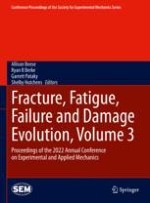2023 | Buch
Fracture, Fatigue, Failure and Damage Evolution, Volume 3
Proceedings of the 2022 Annual Conference on Experimental and Applied Mechanics
herausgegeben von: Allison Beese, Ryan B Berke, Garrett Pataky, Shelby Hutchens
Verlag: Springer International Publishing
Buchreihe : Conference Proceedings of the Society for Experimental Mechanics Series
